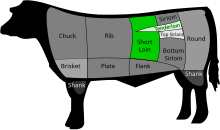T-bone steak
This article needs additional citations for verification. (February 2024) |
 Beef Cuts (American terminology) | |
| Type | Short loin and tenderloin cut of beef |
|---|---|
| Part of a series on |
| Steak |
|---|
The T-bone and porterhouse are
Experts differ about how large the tenderloin must be to differentiate T-bone steak from porterhouse. The United States Department of Agriculture's Institutional Meat Purchase Specifications state that the tenderloin of a porterhouse must be at least 1.25 inches (32 mm) wide at its widest, while that of a T-bone must be at least 0.5 inches (13 mm) wide. [1] However, steaks with a large tenderloin are often called a "T-bone" in restaurants despite technically being porterhouse.
Owing to their large size, and as they contain meat from two of the most prized cuts of beef (the short loin and the tenderloin), T-bone steaks are generally considered one of the highest quality steaks, and prices at steakhouses are accordingly high. Porterhouse steaks are even more highly valued owing to their larger tenderloin.
In British usage, followed in the Commonwealth countries, "porterhouse" often means a British sirloin steak (i.e. US strip steak) on the bone, i.e. without the tenderloin on the other side of T-bone. Some British on-line butchers also offer American style porterhouse steaks.
In New Zealand and Australia, a porterhouse is sirloin steak (strip steak in USA) off the bone.
The earliest mention of the term "porterhouse steak" in a newspaper appears to have been in a letter written by Thurlow Weed that appeared in the Hartford Courant on August 9, 1843, but the following year (August 24, 1844) it also appeared in a list of food prices in The New York Herald, and it appeared regularly in newspapers after that.
Anatomy of the T-bone
To cut a T-bone from
Preparation

T-bone and porterhouse steaks are suited to fast, dry heat
Bistecca alla fiorentina
Cotoletta alla milanese
The same cut of meat, but from a calf, is used for
See also
References
- ^ United States Department of Agriculture (November 2014). Institutional Meat Purchase Specifications (PDF). Fresh Beef Series 100. p. 68. Archived (PDF) from the original on 21 December 2016. Retrieved 18 June 2021.
- ^ Delia Smith:Lamb Archived November 23, 2010, at the Wayback Machine
- ^ LBC:Cooking in the credit crunch Archived 2011-07-27 at the Wayback Machine
- ^ "Buy T Bone Steak | T-Bone Steak for Sale UK". Eat Great Meat. 30 March 2018. Retrieved 2020-08-14.
- .
- ^ Serious Eats (30 May 2014). "How to Grill a T-Bone Steak". Archived from the original on 4 March 2016. Retrieved 5 March 2016.
- ISBN 0-394-72429-1.
External links
- "USDA Institutional Meat Purchase Specifications". Archived from the original on 2014-08-06. Retrieved 2022-03-10. (687 KiB)
- "Beef Cuts Chart" (PDF). Archived from the original (PDF) on 2013-05-03. Retrieved 2011-12-12.
- Porter House name origin article


